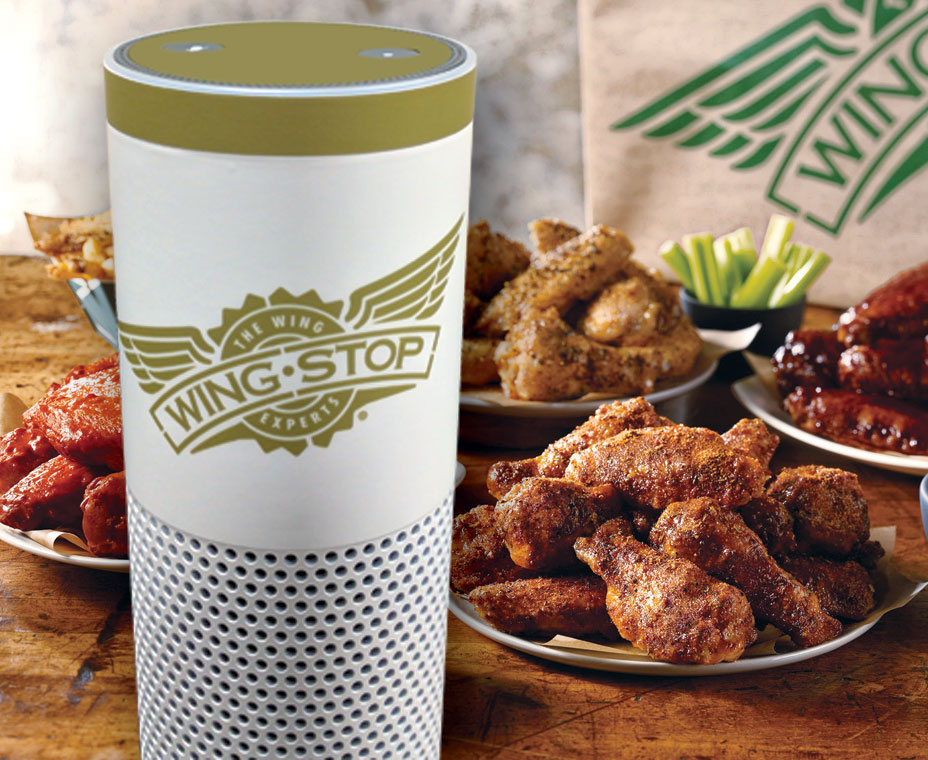Alexa: Order a pizza. Pay for it. Oh, and eat it for me.
Well, the burgeoning world of voice activation isn’t quite there yet. But, much like mobile ordering became the go-to place for millennials and Gen Z to score their meals, voice-activated ordering is fast evolving into fast food’s next big thing.
The numbers are mind-boggling. An estimated 25 percent of 16–24-year-olds use voice search on mobile, reports the Global Web Index. Some 50 percent of all searches will be voice searches by 2020, estimates comScore. A whopping 50 percent of people are now using voice search when researching products, says the website Social Media Today.
A lot to swallow? Perhaps. But for quick-service and fast-casual chains with one eye on sales growth and another eye on the future, voice-activated ordering already is in fourth gear. Major chains from Domino’s to Pizza Hut to Wingstop to KFC are embracing voice activation—though none claim to have perfected it.
Few chains are pushing harder in the world of voice-activated ordering than Wingstop, the Dallas-based chain known for its chicken wings. With takeout being such a huge part of Wingstop’s business—making ordering ahead increasingly common—it launched voice-activated ordering early in 2017.
The key target is millennials. “Voice activation has become common in their homes and on their phones,” says Kevin Fish, vice president of digital technology at Wingstop, which has 1,031 locations globally and is in all 50 states.
Wingstop was an early adopter of digital ordering, rolling out the platform in 2009. Fast-forward to today and digital ordering across all channels—including voice activation—now accounts for more than 20 percent of sales, Fish says. Its recent move to use Amazon’s Alexa “forced us to rethink the ordering process from the ground up,” he says.
Voice-activated ordering requires some set-up. To get started, Alexa users must link their Wingstop account. They can then activate a Wingstop order by using simple vocal prompts such as, “Alexa, ask Wingstop to order wings.”
There are challenges with voice-activated orders. For one, there’s no screen for customers to look at and affirm their orders. Another challenge is designing the experience so that the app responds correctly; Wingstop had to build a conversation that’s easy for the customer to follow, yet there still has to be easy access to customization, which is a key to store profits. “To build a skill for Alexa to reach thousands and thousands of combos is a real challenge,” Fish says.
Simple options need to be understood, such as whether or not the customer wants their order of chicken wings bone-in, boneless, or a mixture of the two. Various voice-activation prompts had to be built into the process step by step in order to clarify what the customer wants.
Then there’s the issue of twang. Wingstop is based in Texas, where many folks speak with dialects. “It’s been interesting to see how Alexa hears people with different dialects and accents,” Fish says. Because Wingstop worked directly with Amazon, these design challenges were mostly solvable upfront, he says.
Because all forms of digital ordering are ultimately integrated at Wingstop, the order looks the same as any other order when it arrives in the kitchen, so little employee training is required for voice activation, Fish says.
Far ahead of the voice-activated ordering curve is Domino’s, which way back in 2014 introduced “Dom.” While Dom sounds like a real person, it’s a computer-generated male voice that takes orders on Domino’s food-ordering app. The virtual voice-ordering assistant integrated into Domino’s ordering apps for iPhone and Android devices makes it a human-like, conversational experience.
Dom, however, was just “phase one” of Domino’s voice-activation implementation, says Dennis Maloney, chief digital officer at Domino’s. Phase Two, he says, was linking with Amazon Alexa and Google Home devices, which began nearly 18 months ago. Phase Three, which Domino’s already has in stores but is still being tweaked, is the “true, conversational chatbox,” Maloney says. Under this phase, Domino’s is working to broaden voice ordering to the entire suite of Domino’s products.
All of this has a single goal: to make pizza ordering simpler so that Domino’s can sell more pizza. Maloney points to how simple it can be to order a Domino’s pizza via Alexa without even lifting a finger. A customer can lie down on the couch in one room and order a pizza from Alexa in the next. By simply asking Alexa to open the Domino’s account, an order can be automatically placed, confirmed, and delivered.
“Every time I think we’ve created an easy-as-possible way to order pizza, we come up with one that’s easier,” Maloney says.
But one issue that Domino’s—and everyone else in the industry—is dealing with is security in an age of voice activation. Many people don’t like to say their credit-card numbers out loud, and others don’t like to store those credit-card numbers in a company’s account. “So there are a lot of bits and pieces coming together now that we have to build processes around,” Maloney says.
He adds that one surprising thing is many consumers interact with voice activation as if they’re talking to a person. “Sometimes people will be very polite,” Maloney says. “But other times people can get very angry, too. Instead of talking to it like it’s a computer, they talk as if it’s a real person.”







